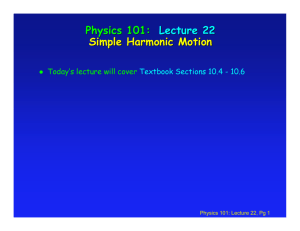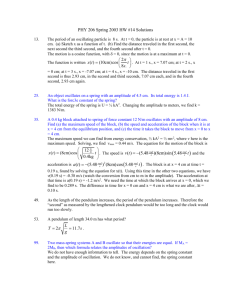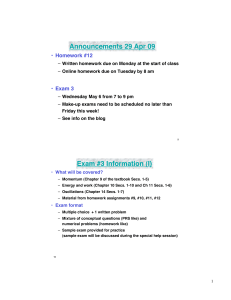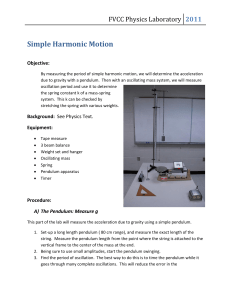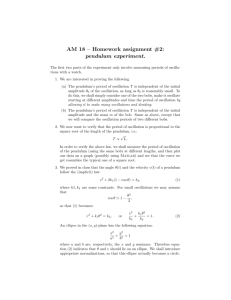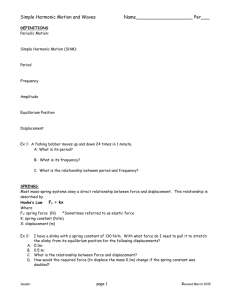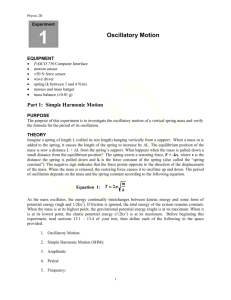Simple Harmonic Motion
advertisement
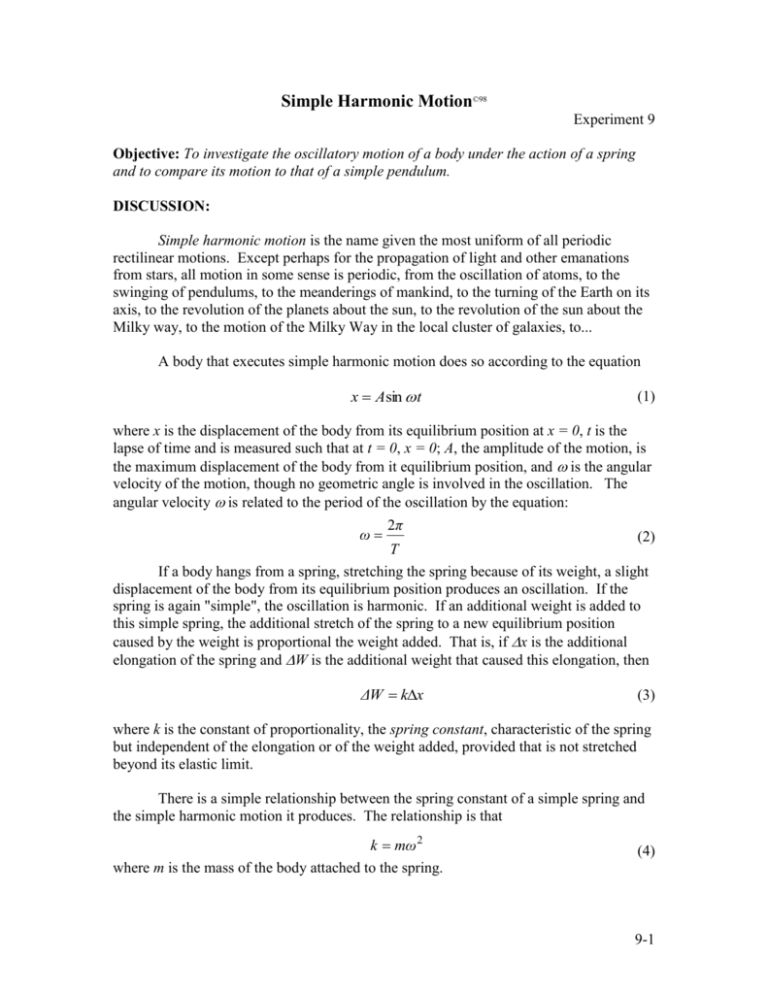
Simple Harmonic Motion©98 Experiment 9 Objective: To investigate the oscillatory motion of a body under the action of a spring and to compare its motion to that of a simple pendulum. DISCUSSION: Simple harmonic motion is the name given the most uniform of all periodic rectilinear motions. Except perhaps for the propagation of light and other emanations from stars, all motion in some sense is periodic, from the oscillation of atoms, to the swinging of pendulums, to the meanderings of mankind, to the turning of the Earth on its axis, to the revolution of the planets about the sun, to the revolution of the sun about the Milky way, to the motion of the Milky Way in the local cluster of galaxies, to... A body that executes simple harmonic motion does so according to the equation x Asin t (1) where x is the displacement of the body from its equilibrium position at x = 0, t is the lapse of time and is measured such that at t = 0, x = 0; A, the amplitude of the motion, is the maximum displacement of the body from it equilibrium position, and is the angular velocity of the motion, though no geometric angle is involved in the oscillation. The angular velocity is related to the period of the oscillation by the equation: ω 2π (2) T If a body hangs from a spring, stretching the spring because of its weight, a slight displacement of the body from its equilibrium position produces an oscillation. If the spring is again "simple", the oscillation is harmonic. If an additional weight is added to this simple spring, the additional stretch of the spring to a new equilibrium position caused by the weight is proportional the weight added. That is, if x is the additional elongation of the spring and W is the additional weight that caused this elongation, then ΔW kx (3) where k is the constant of proportionality, the spring constant, characteristic of the spring but independent of the elongation or of the weight added, provided that is not stretched beyond its elastic limit. There is a simple relationship between the spring constant of a simple spring and the simple harmonic motion it produces. The relationship is that k mω 2 where m is the mass of the body attached to the spring. (4) 9-1 The body which hangs from a spring is an easily prepared example of oscillatory motion because, except for the pull of gravity and a little friction from the air, only the spring acts on the body. The weight of the body, except for providing the initial elongation of the spring which sets the equilibrium, does not affect the oscillation of the body. However, the mass of the spring, since the spring takes part in the oscillation, must be included in Eq. (4), relating spring and angular frequency. Not all parts of the spring oscillate with the same amplitude, i.e. one end of the spring is fixed and the other end moves with the body. The effect of this is that only one third of the mass of the spring is included in the mass of the oscillating body. A mass-spring system provides a good illustration of conservation of energy. The kinetic energy of the system is given by (5) 1 K mv 2 . 2 The potential energy is U 1 2 kx2 mgx , (6) where x is the distance away from equilibrium. Neglecting friction, the total mechanical energy K U 1 1 mv 2 kx2 mgx 2 2 (7) is a constant. The influence of the weight of the body may be eliminated by considering harmonic motion in a horizontal plane. Such motion may be prepared by placing a cart on a level air-track and attaching to the end of a cart two springs, one fixed at the right side of track and the other fixed at left side. It can be shown that if the spring constants of the spring are k1 and k2, the motion of the cart is the same as though it were acted upon by a single spring whose constant is k1+k2. Next, we consider the motion of a simple pendulum which ideally is a point particle swinging at the end of a massless string. It can be shown that the motion of the bob is simple harmonic provided that the amplitude of the motion is small. The period of this motion is given by T 2π (8) g where is the length of the pendulum from the point of support to the center of mass of the bob, and g is the local acceleration due to gravity, 9.8 m/s2. Note that the period is independent of the mass of the bob. 9-2 Apparatus Setup: We will need a motion sensor to track the motion of the oscillating spring. This is a sonic device, much like a radar detector, that sends out pulses of very high frequency (above our hearing) sound and receives them when they are reflected from an object. You may notice a "clicking" sound from the detector; each click is a sent and received pulse. 1. Setup the Signal Interface and photogates as shown in Fig. 1. a. Plug the power brick into the back of the Interface, then into the strip on your table. b. Connect the white cable into the back of the Interface then into your computer’s USB port. c. Plug the motion sensor’s yellow lead into Channel 1. d. Plug the motion sensor’s other lead into Channel 2. e. Plug a photogate into Channel 3. This will be photogate 1. f. Turn on the Interface (switch is on the back). 2. Start DataStudio. It should be located somewhere under your start menu. 3. When prompted, choose ‘Create Experiment’. 4. Set up the software to recognize the hardware: a. In the software, add a “Motion Sensor” to Channel 1. Notice that it automatically assumes the yellow lead is in Channel 1 and the black lead is in Channel 2. b. Add a “Photogate and Pendulum” to Channel 3. c. Add a “Photogate and Pendulum” to Channel 4. 5. Set up the graphs a. Notice that there is a list of Data options on the upper left (usually). Also notice that there is a list of Display options on the bottom left (usually). b. Click and drag the Graph icon onto “Position, Ch 1&2 (m)” to create a graph of Position vs Time. c. Click and drag the Graph icon onto “Velocity, Ch 1&2 (m/s)” to create a graph of Velocity vs Time. 9-3 d. Click and drag the “Graph” icon onto “Acceleration, Ch 1&2 (m/s)” to create a graph of Velocity vs Time. e. Resize your graph window and move it so you can see everything. EXERCISES FOR THE SUSPENDED OSCILLATOR: Preliminary Data: We will measure the spring constant of the large spring using a "manual" technique. This value can then be compared to the value derived with the "computer" technique. 1. Measure the length of the unstretched spring. 2. Suspend a number of known weights from the spring and measure the length of the stretched spring. 3. Using Hooke's Law, F=kx, where x is the difference between the stretched length and the unstretched length and F is the weight (not mass!) of the weight, make several calculations of k. 4. Find an average value for k. 5. Measure the mass m of the spring. 6. Calculate the spring’s effective mass (⅓ of its actual mass). Data Acquisition: The position and velocity of the oscillating spring and masses will be shown on a graph in DataStudio. Each new run in DataStudio will be of a different mass/spring combination. These graphs will be used later to calculate the potential energy, U, and the kinetic energy, K, of the system, so the data file will need to be saved for later reference. 1. Choose a hanging mass or combination of hanging masses between 150g and 300g. 2. Hang this mass combination from the spring in such a way so that the bottom mass has the largest bottom surface area. Place a piece of masking tape over the bottom of the last mass to ensure a flat bottom for a good signal. See Figure 2. 3. In DataStudio: a. Find the “Motion Sensor” Tab. In version 1.9.7r8, this is found by clicking on the motion sensor. Figure 2: Hang masses so that the bottom one has the largest surface area towards the sensor. b. Enter the calibration (standard) distance which the distance between the bottom of the suspended mass on the stretched spring and the motion sensor. 4. Set the spring in motion with a small amplitude. 9-4 5. Click on the ‘Start’ button in the main DataStudio window to record data. 6. Allow the spring to oscillate about 10 seconds. 7. Click on the ‘Stop’ button when complete. 8. Using one of the graphs generated, measure the period of oscillation by measuring the time from peak to peak. 9. Repeat the entire process (steps 2-9) for several masses (all between 150g and 300g). DO NOT USE MORE THAN 300g!!! 10. Save the SHO data. Data Analysis: Again, Excel will be used to analyze the data gathered. Theoretical values of k and T will be found and compared to those that were measured. Finally, the energy of the system will be explored. 1. Construct a graph showing the squared period of oscillation T2 as a function of the sum of the mass of the suspended body and the effective mass of the spring ∑m+me. 2. Find the slope of the line, m, and use it to calculate an experimental k value using the following equation: k 4π 2 m 3. Compare this value with the measured k value. 4. Calculate the theoretical periods of each body from Eqs. (2) and (4). 5. Calculate the percent error of the measured periods from the theoretical periods. 6. Using the graphs from the data acquisition section, calculate the potential, kinetic, and total energy of the system at three nearby points: a. at the zero point of the motion, b. at the point of maximum displacement, c. at a time midway between these two. (Note that the x in Eqs. (6) and (7) are the displacement from equilibrium.) 7. Calculate the average total energy, and the percent deviation of each of the three determinations from the average. 9-5 EXERCISES FOR THE SIMPLE PENDULUM Preliminary Data: Since a pendulum is also an oscillating system, we can draw similarities between it and the spring/mass system. A "spring constant" for the pendulum will be calculated; note, of course, that there is no real spring present. 1. Starting from Eq. (4), derive an expression that is length dependent for the “spring constant” associated with the pendulum. 2. Is the period T of the pendulum mass dependent? Data Acquisition: The period and length of the pendulum will be tabulated for use in the analysis section. 1. Save your SHO data. 2. Close the graphs. 3. Make sure the bob (mass) cuts the photogate cleanly. You may have to tape around the bottom to cover the holes. 4. Find the “Constants” menu for the first photogate. In version 1.9.7r8, this tab is in the menu that is seen when you click on the photogate icon shown connected to the interface. 5. Enter the width of the mass that is being used as the bob. 6. Click and drag the “Table” icon “Period, Ch 3 (s)”. 7. Resize and move the table so you can see everything. 8. Click on ‘Start’ in the main window to record data. 9. When the reading of period value is fairly steady, click on ‘Stop’. 10. Measure the length of the pendulum. (note: this length is from the pivot point to the center of the bob.) 11. Repeat 5-7 for several different lengths. Data Analysis: From Eq. (8), an experimental value for g will be obtained using the data collected in the previous part. This can then be compared to the actual value of g. 1. For each period and length measured, calculate the value g. 2. Calculate the average value of g from the above calculations for g and determine the percent deviation of each from the average. 3. Assuming the true value of g to be 9.80 m/s2, calculate the percent error of your average from the true value. 9-6

